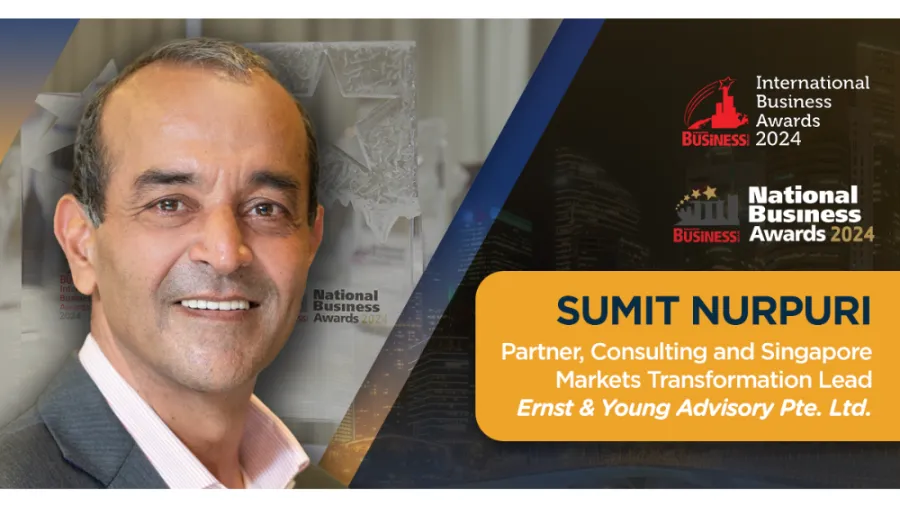
EY’s Sumit Nurpuri emphasises tailoring strategies for diverse ASEAN markets, navigating cross-cultural environments for optimal growth
Discover how emerging technologies, sustainability trends, and Singapore's evolving business ecosystem play pivotal roles in shaping the future of businesses in an increasingly digitised world.
In the fast-paced landscape of digital transformation, businesses are continually seeking ways to innovate, adapt, and thrive. The relentless evolution of digital technologies has not only become a driving force for change but also a decisive factor in determining the competitiveness and sustainability of enterprises across the globe.
As the Partner, Consulting, and Singapore Markets Transformation Lead at Ernst & Young Advisory Pte. Ltd., Sumit Nurpuri is at the forefront of shaping technology-enabled strategic transformation deals in Southeast Asia. With a background in Chief Operating Officer roles and Head of Strategic Large Deals for the Asia-Pacific region, he specialises in shaping technology-enabled strategic, multitower transformation deals in Southeast Asia.
Nurpuri's expertise lies in helping businesses undergoing substantial changes to formulate and execute digital transformation strategies. With a wealth of experience, he shares valuable insights into the challenges, opportunities, and effective strategies for businesses navigating the dynamic realm of digital transformation.
As a judge in the 2024 SBR National Business Awards and International Business Awards, Nurpuri delves into the intricacies of digital transformation, offering profound insights for businesses seeking growth and innovation. The discussion covers a range of topics, from the challenges and opportunities in the diverse ASEAN market to effective strategies for driving large-scale growth.
You have an impressive background in shaping technology-enabled strategic transformation deals in Southeast Asia. Can you share some insights into the key challenges and opportunities you've encountered in this region and how businesses can navigate them successfully?
ASEAN is a huge and diverse region. With different local government regulations, stages of economic development, infrastructure maturity, levels of disposable income, and consumer demographics, we cannot use the same playbook when we approach the various ASEAN markets.
Every business strategy has to be tailored to optimise investment and sustain growth. Organisations need to equip themselves with the know-how to navigate cross-cultural business environments, legal guidelines, and regulatory considerations. At EY, we have consultants who understand the local market and speak the language. By adopting a whole-of-firm proposition that brings together capabilities in strategy, transactions, business consulting, technology consulting (covering artificial intelligence (AI), data, and cybersecurity), and people advisory services, we are able to develop comprehensive solutions for our clients.
ASEAN’s non-homogenous characteristic also presents opportunities for organisations. Emerging markets enable organisations to expand their current consumer base by offering tried and tested products and services, whilst the more developed ones allow for experimentation and innovation. As one of the fastest-growing economies in the world, the region is experiencing rapid urbanisation and an expanding middle class. Its booming digital economy is the result of an increasing population of internet and mobile phone users, and efforts to improve connectivity between markets. This is good news for organisations looking to scale their business in ASEAN.
What strategies have you found to be most effective in driving growth and transformation on a large scale?
One of the most effective strategies is putting humans at the centre of transformation and growth. Our research with the University of Oxford shows that in doing so, the probability of success increases by 2.6 times. There are six key drivers:
- Effective leadership and management teams that promote collaboration and open communication;
- Clear vision that gets buy-in from internal stakeholders;
- Organisational culture that embraces and encourages everyone’s opinion;
- Change management strategy that outlines roles and responsibilities whilst at the same time giving room for experimentation;
- Investments into the right technologies and training and development opportunities for employees to prepare for plausible job redesigns; and
- Collaborative relationships between leadership and management teams and their employees
Aside from Humans@Center, EY’s “Transformation Realized” consulting strategy also includes Innovation@Scale and Technology@Speed. What this means is that organisations must embed innovation into their culture and business models, as well as be quick and nimble in adopting new technologies whilst balancing the practical considerations of transformation.
In your current role at EY, what emerging trends and technologies do you believe are most impactful for businesses in Singapore and Southeast Asia, and how should companies leverage these trends to drive growth and transformation?
Emerging technologies like AI, data analytics and business intelligence are already transforming industries. The EY CEO Outlook Pulse Q3 2023 found that 66% of Singapore respondents view AI as a driving force when it comes to business efficiency. Organisations can use AI to automate manual and repetitive tasks, develop intelligent products and services, and create a differentiated customer experience. Similarly, by leveraging data, organisations can create intelligence and insights that allow them to better understand their consumers, analyse the latest market trends, and improve and innovate new products and services.
Trend-wise, the digital economy, leapfrogged by the pandemic, has significantly altered consumers’ shopping behaviours. The 13th edition of the EY Future Consumer Index (FCI) highlighted that 56% of consumers in Southeast Asia prefer to shop mostly online and only 4% are willing to shop mostly in-store. Year-on-year, between 2022 and 2023, there is an 11 percentage point increase in preference for online shopping. We envision this will continue to rise. Organisations need to look at incorporating more digital touchpoints, such as digital payment systems and mobile applications, and optimising their digital service delivery in order to retain and attract consumers.
The other trend is leveraging technologies that drive sustainable outcomes. We foresee more policies and regulations that will make sustainability mandatory for business operations. According to the EY FCI, 63% of consumers in Southeast Asia view sustainability as extremely crucial in their purchase decisions. Governments and consumers will only continue to pressure and demand organisations to be more sustainable. Incorporating green technologies and sustainability initiatives as early as possible will help organisations future-proof their business.
Can you provide insights into how Singapore's business ecosystem is evolving, and what should businesses do to position themselves effectively in this dynamic environment, especially in the context of fast-growing digital markets?
In addition to a pro-business environment and regulatory stability, Singapore has a reliable intellectual property regime, and our standards have earned the trust of people, businesses and governments worldwide.
Last year, the Singapore Economic Development Board (EDB) attracted S$22.5b in fixed asset investment commitments, cementing the country’s reputation as a trusted hub for capital, talent, flows of goods and data, and innovation. It also secured S$6.2b in total business expenditure, indicating more global organisations use Singapore as a springboard to access regional and international markets. These commitments are increasingly flowing towards the digital economy, including fintech, cloud technologies, and cybersecurity. Notably, billions of dollars of trading volumes have shifted to Asia, concentrating on the digital asset centre, Singapore.
The outlook for the digital economy remains positive. More customers are using alternative platforms like social media to discover and interact with brands and make purchases. Organisations can take advantage of Singapore’s business fundamentals and develop capabilities in emerging technologies like AI and cybersecurity so that they can seize opportunities in this space. On top of that, it is worthwhile to explore creating an ecosystem through partnerships and knowledge exchange with peers, both local and foreign.
What advice would you offer to companies seeking to expand globally, and what are the key considerations they should keep in mind to successfully enter new markets?
In the earlier question (Q1), we discussed the need for organisations to equip themselves with the know-how to navigate cross-cultural business environments, legal guidelines, and regulatory considerations. This know-how does not only apply when entering ASEAN markets. It applies to global expansion too.
A few key considerations would be to first assess market readiness and chart their internationalisation strategy along with desired growth outcomes, conduct in-depth research on the business, regulatory and customer landscapes, as well as strengthen internationalisation capabilities by finding suitable in-market partners and grooming their talent. As consultants, we also help clients monitor, manage and mitigate enterprise, financial, and technology risks. End-to-end supply chain and operations resilience is key for organisations looking at business expansion. Through our work with expert organisations from across our global ecosystem and targeted acquisitions, we are able to bring in complementary skills to bolster design, technology, innovation and analytics capabilities for our clients.
Organisations can also look at tapping government resources. For example, the EDB Corporate Venture Building Program supports organisations to incubate innovative business ideas which have the potential to be globally competitive, and Enterprise Singapore’s financing programmes from the Market Readiness Assistance Grant (first-timers into new markets) to the Double Tax Deduction for Internationalization (tax deduction on eligible market expansion costs), and the International Co-Innovation Program which promotes cross-border co-innovation projects.
What are the specific criteria and attributes that you look for when evaluating businesses for the SBR National Business Awards and International Business Awards?
Responsibility, innovativeness and agility.
Responsibility not only to external stakeholders like investors and consumers, but more importantly, their employees. Responsibility to society and communities at large through sound and sustainable business practices.
Innovativeness is not limited to the technology criteria. Innovativeness also applies to the organisation’s operating model and working culture. SBR award winners should be bold and experimental when it comes to embracing creativity and continuous improvement.
Agility means being flexible and responsive to evolving market conditions and being open to different business environments and practices, especially for those with global ambitions.



![SBR 5 Lorem Ipsum News 2 [8 May]](https://cmg-qa.s3.ap-southeast-1.amazonaws.com/s3fs-public/styles/exclusive_featured_article/public/2025-05/a_hand_pointing_to_a_futuristic_technology_5b87c9d0e3_3.png.webp?itok=M3Hf-9XR)
![SBR 4 Lorem Ipsum [8 May Top Stories]](https://cmg-qa.s3.ap-southeast-1.amazonaws.com/s3fs-public/styles/exclusive_featured_article/public/2025-05/a_hand_pointing_to_a_futuristic_technology_5b87c9d0e3_2.png.webp?itok=2m5Wl0MX)


![Exclusive three SBR 12 Lorem Ipsum [8 May]](https://cmg-qa.s3.ap-southeast-1.amazonaws.com/s3fs-public/styles/exclusive_featured_article/public/2025-05/a_hand_pointing_to_a_futuristic_technology_5b87c9d0e3_11.png.webp?itok=8kn_UIfA)
![SBR 3 Lorem Ipsum [ Exclusive 2]](https://cmg-qa.s3.ap-southeast-1.amazonaws.com/s3fs-public/styles/exclusive_featured_article/public/2025-05/a_hand_pointing_to_a_futuristic_technology_5b87c9d0e3_1.png.webp?itok=YCyjLegJ)
![SBR 2 Lorem Ipsum [8 May]](https://cmg-qa.s3.ap-southeast-1.amazonaws.com/s3fs-public/styles/exclusive_featured_article/public/2025-05/a_hand_pointing_to_a_futuristic_technology_5b87c9d0e3_0.png.webp?itok=_cKD-29o)

![Video [Event News]](https://cmg-qa.s3.ap-southeast-1.amazonaws.com/s3fs-public/styles/event_news_featured_article/public/2025-05/screenshot-2025-05-08-at-4.58.53-pm_0.png.webp?itok=Kud35sMs)
![Event News SBR 9 Lorem Ipsum [8 may]](https://cmg-qa.s3.ap-southeast-1.amazonaws.com/s3fs-public/styles/event_news_thumbnail/public/2025-05/a_hand_pointing_to_a_futuristic_technology_5b87c9d0e3_8.png.webp?itok=DTh_dbYp)
![Event News SBR 9 Lorem Ipsum [8 May]](https://cmg-qa.s3.ap-southeast-1.amazonaws.com/s3fs-public/styles/event_news_thumbnail/public/2025-05/a_hand_pointing_to_a_futuristic_technology_5b87c9d0e3_7.png.webp?itok=vzDAzb6V)
![Event News SBR 8 Lorem Ipsum [8 May]](https://cmg-qa.s3.ap-southeast-1.amazonaws.com/s3fs-public/styles/event_news_thumbnail/public/2025-05/a_hand_pointing_to_a_futuristic_technology_5b87c9d0e3_6.png.webp?itok=jvHFc4P6)
![Video [Event News]](https://cmg-qa.s3.ap-southeast-1.amazonaws.com/s3fs-public/styles/video_thumbnail/public/2025-05/screenshot-2025-05-08-at-4.58.53-pm_0.png.webp?itok=yZnI0YBb)
![Video 1 SBR [8 May]](https://cmg-qa.s3.ap-southeast-1.amazonaws.com/s3fs-public/styles/video_thumbnail/public/2025-05/screenshot-2025-05-08-at-4.58.53-pm.png.webp?itok=9AAeRz_k)

 Advertise
Advertise

